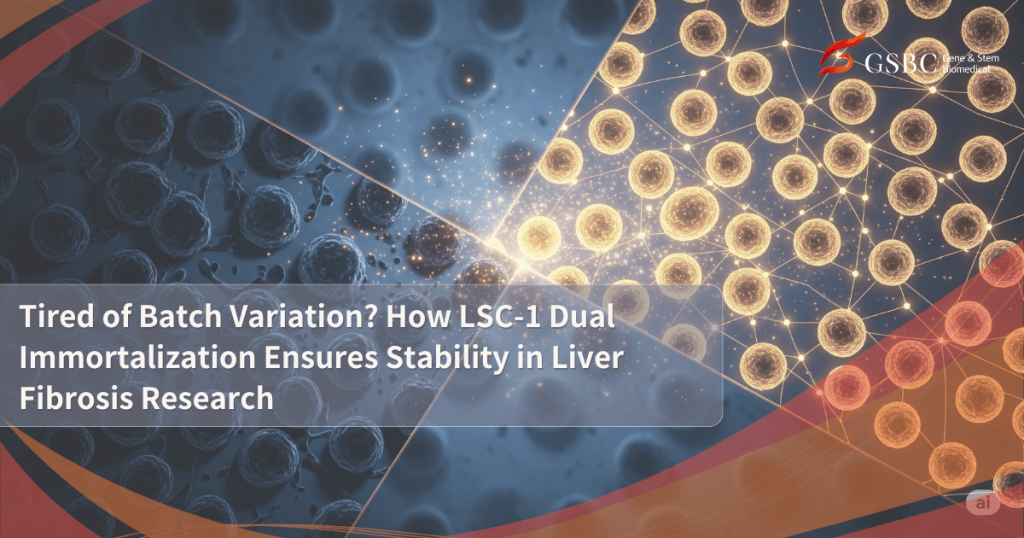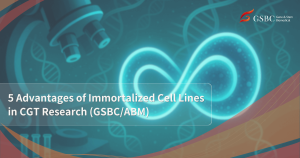
In the quest to develop drugs for liver fibrosis or NASH, have you ever been frustrated by the inherent instability of primary cells? Their limited lifespan, high procurement costs, and—most critically—significant batch-to-batch variation can introduce uncontrollable variables into your data, potentially stalling your entire research project.
It’s time to say goodbye to that uncertainty. Gene & Stem Biomedical’s (GSBC)
LSC-1 (Cat. No. T0429) immortalized human hepatic stellate cell line was engineered to solve these core challenges, providing an unshakable foundation for your liver fibrosis research.
What is Dual Immortalization and Why is it Key to Stability?
The lifespan of primary cells is limited by telomere shortening that occurs with each cell division. To overcome this, the LSC-1 cell line was created using state-of-the-art
hTERT + SV40 dual-immortalization technology.
- hTERT (human Telomerase Reverse Transcriptase): Acts as a “biological clock repairman,” constantly replenishing telomere length to allow cells to proliferate indefinitely without senescence.
- SV40 T-antigen: Bypasses key cell cycle checkpoints, ensuring that cells divide consistently and robustly.
This powerful combination endows LSC-1 with unparalleled stability. It means that the cells you use for every experiment will have highly consistent biological characteristics, fundamentally eliminating the experimental variability caused by batch-to-batch differences.
Not Just Stable—An Authentic Fibrosis Phenotype
While stability is crucial, a great disease model must also faithfully mimic the in vivo physiological state. LSC-1 excels in this area by preserving the key features of hepatic stellate cells during the fibrotic process:
- Preserves Key Protein Markers: It consistently expresses critical fibrosis markers, including PDGFRβ, αSMA, and Type I collagen.
- Simulates Dynamic Activation: It can toggle between quiescent and activated states in response to stimuli, authentically simulating the dynamic progression from NAFLD to fibrosis.
This makes LSC-1 more than just a stable cell platform; it’s a
high-fidelity research tool that accurately models disease pathology and predicts true drug efficacy.
Direct Benefits for Your Research
Choosing LSC-1 means selecting a more efficient and economical research pathway:
- Reliable Data: Maximize the reproducibility of your experiments, making your findings more robust and publishable.
- Reduced Costs: Its infinite lifespan eliminates the need for repeated purchases of expensive primary cells. Its high-throughput design also reduces reagent and time costs, making it ideal for startups and academic labs.
- Accelerated Progress: A stable platform streamlines drug screening and mechanistic studies, helping your project achieve breakthroughs faster.
Ready to elevate your liver fibrosis research?
Explore the LSC-1 cell line today and experience a new level of stability and reproducibility .
Further Reading & Related Research
- On the Development and Characterization of Hepatic Stellate Cell Lines
- On the Mechanisms of Hepatic Stellate Cell Activation
- Tsuchida, T., & Friedman, S. L. (2017). Mechanisms of hepatic stellate cell activation. Nature Reviews Gastroenterology & Hepatology, 14(7), 397–411. Nature
- On the Application of Immortalized Hepatic Stellate Cell Lines in Anti-Fibrotic Drug Discovery
- Loret, E., Lévesque, S., & Vasseur, P. (2023). Hepatic stellate cell immortalization and their use as a cell-based model for anti-fibrotic drug discovery. Frontiers in Pharmacology, 14, 1182295. Frontiers

